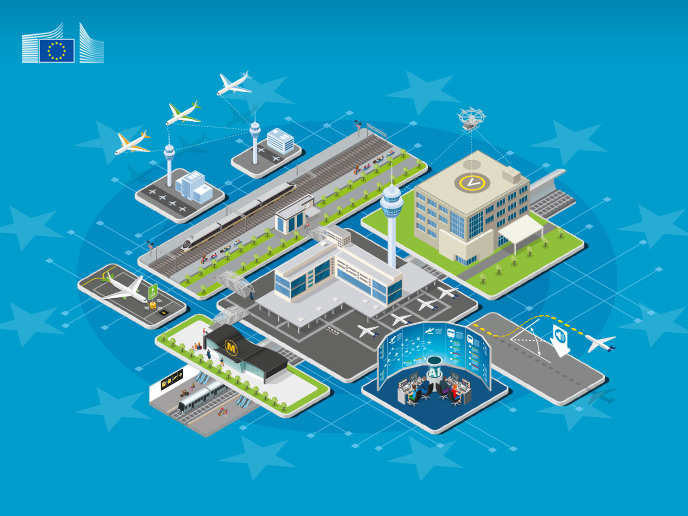Connecting the dots: smarter airports and seamless mobility powered by SESAR JU
Europe’s sustainable and smart mobility strategy(opens in new window) envisages connected and automated multimodal mobility – where passengers can seamlessly travel door to door. At the same time, it – along with the European Green Deal(opens in new window) and Fit for 55(opens in new window) plan – calls for smarter, more sustainable aviation operations on the ground and in the air. Airports sit at the intersection of these ambitions, acting as vital hubs within the transport network. SESAR JU drives digitalisation in all aspects of air traffic management, including at airports, by integrating advanced technologies, such as artificial intelligence, big data analytics and automation. These innovations enhance the efficiency of airport operations through improvements in collaborative decision-making, situational awareness, managing possible disruptions, and passenger flow management. They also ensure that airports operate as integral components of a broader European transport ecosystem, while preparing for the integration of innovative air mobility (IAM) and urban air mobility (UAM). The projects highlighted in this Pack, supported through the SESAR JU, work to improve multimodal mobility by linking airports with ground transport modes, in particular rail and emerging forms of connected and automated mobility. They explore how enhanced data sharing allows seamlessness of transfers between air and rail, reducing travel times, improving coordination and connectivity, and enhancing the overall passenger experience. This transformation is supported by the development of mobility-as-a-service (MaaS) platforms that unify booking, ticketing and real-time updates across different transport providers. These advances are underpinned by efforts across Europe to enable interoperable digital mobility services and shared data spaces, helping to break down silos between transport modes and operators. SESAR JU is at the forefront of this transformation, promoting smart infrastructure such as digital twins, which provide real-time simulations of airport operations to support operational planning, and remote towers, allowing air traffic control to be managed off-site using high-definition cameras and sensor data. These solutions help to enhance flexibility, reduce infrastructure costs and support smaller airports with limited resources. The projects featured also leverage advanced communication, navigation and surveillance (CNS) technologies, and predictive tools to improve the management of aircraft and vehicles on the ground and in the terminal manoeuvring area. The projects in this Pack further support more sustainable, dynamic and predictable airport operations by developing tools that enable airports to better anticipate, monitor and manage aircraft movements and to steer overall performance. These solutions allow for more accurate departure planning, improved traffic flow information and real-time environmental assessments. By enhancing situational awareness, operational coordination and performance analysis, they support smarter decision-making across the airport ecosystem. Coupled with efforts to improve connectivity between regional airports across Europe and the European air traffic management network, these innovations help optimise airside operations, reduce emissions and noise, and contribute to a more efficient and environmentally responsible air traffic system. Research and demonstration projects powered by SESAR JU are instrumental in testing new ideas and concepts in real-world airport environments. These efforts are vital in making Europe’s transport system more resilient, efficient and environmentally sustainable, ensuring it meets the demands of the future.



